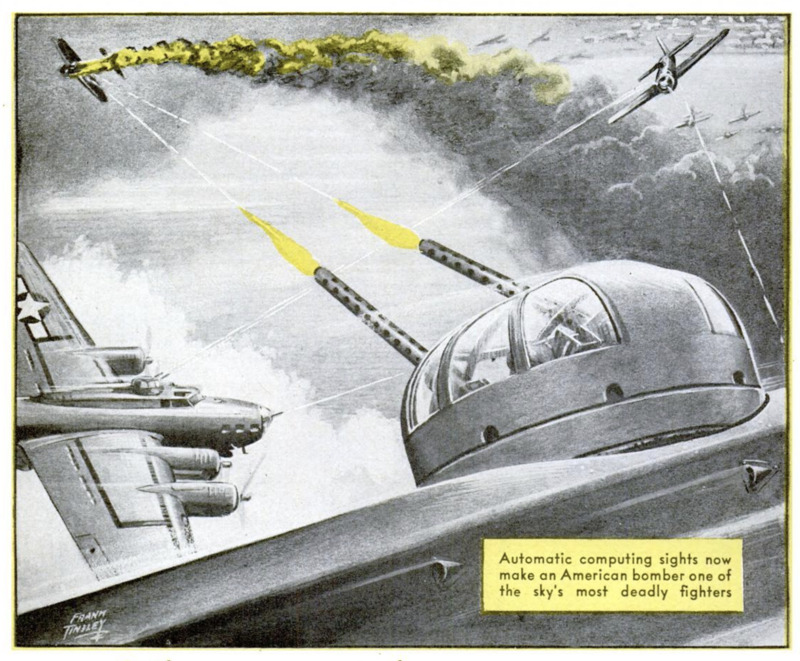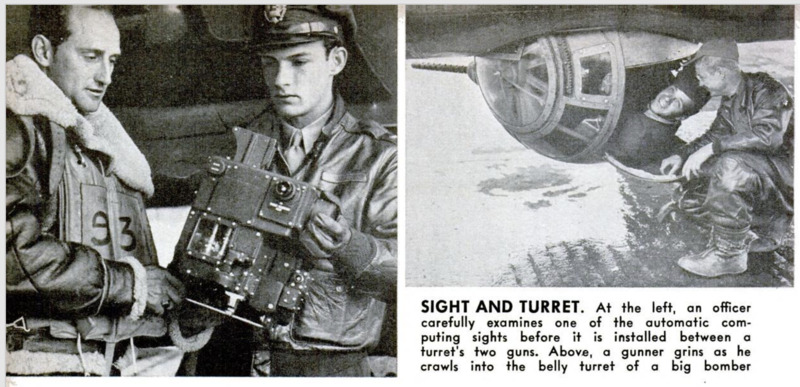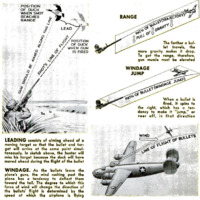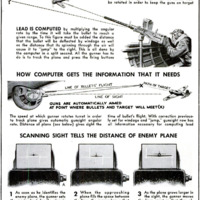-
Title (Dublin Core)
-
Why our aerial gunners are Outshooting the Axis
-
Article Title and/or Image Caption (Dublin Core)
-
Why our aerial gunners are Outshooting the Axis
-
extracted text (Extract Text)
-
AMERICA'’S big bombers, which roared to
fame as tough ships that could “lay
eggs in a basket” from 20,000 feet and take
terrific punishment, are even more famous
now as killers of the sky. On one bombing
mission, not long ago, a flight of them
knocked out 74 Nazi fighters. Good to be-
gin with, they are now superbly lethal.
How come? The answer is gunnery—
gunnery that is more than weapons, more
than power turrets, more than competent
gunners. It is all these, plus an automatic
computing gunsight that makes supermen
of the bombers’ gun crews. This automatic
sight has given our big ships a fire-power
“reach” of more than 1,000 yards, or twice |
the effective range of Axis aerial guns.
Until recently this automatic sight was a
secret weapon. Its details are still secret, but |
the veil has been lifted enough to show what |
it can do and, in general, how it does it. Basi- |
cally, it is a compact machine that automat- |
ically calculates speed, drift, windage, tra-
Jjectory, and range, and compensates for all |
these factors as it aims the guns where the
bullets will do the most damage to an eneray
plane. It does all this with a minimum of hu-
man effort, and reduces human error to a |
minor factor by eliminating virtually all
guesswork. And, lastly, it is so simple to
operate that three weeks’ training with it
can make an expert gunner out of a novice.
Any duck hunter or trapshooter has a
rough idea of the primary problems of an
aerial gunner. First of all, to hit a moving
target he must “lead” it, that is, shoot far
enough ahead of it to allow for its speed.
Then he must take into account the range
of his gun, the effect of the wind, and the
characteristics of the shell he is shooting.
The duck hunter's target, however, sel-
dom flies more than 60 miles an hour. The
aerial gunner’s target travels more than six
times as fast. And while the duck hunter
shoots from a stationary position, the aerial
gunner is in a bucking, twisting ship travel-
ing at least 200 miles an hour. The duck
hunter uses a shell whose hundreds of tiny
pellets are deadly over a three-foot circle
at 50 yards. The aerial gunner's weapon
fires only one bullet at a time. To approxi-
mate the aerial gunner's task, the duck
hunter would have to do his wing shooting
with an automatic rifle while sitting in the
rumble seat of a -ar going down a country
road at : ) miles an hour. Accurate shoot-
ing from a big bomber with manually op- |
erated weapons ond ordinary sights is phe- |
nomenal. Man simply is not physically
equipped to <7 it.
Of his equipment, his eyes are probably |
nearest to the necessary perfection. When
a bomber is flying at 200 miles an hour and
an oncoming pursuit ship is moving at 400
miles an hour, the combined speed of ap- |
proach is 300 yards a second, which is not
very far from the speed of sound. Yet a |
gunners eye can follow a pursult ship travel- |
ing at that terrific speed. In a wink of the |
eye, however, the target will have moved
about 25 yards. And we know from optical
research that persistence of vision makes
the eye incapable of registering an abrupt
change nating less than 1/32 of a second. |
The eye Is fallible to degree not vet fully
determined; but, on the whole, it is good
enough for the aerial gunner's Job.
A man's physical reflexes ure less de- |
pendable. But because of thelr importance,
the Air Forces insist on high standards. Im:
pulses from the eye or ear must be obeyed
by the muscles without perceptible delay.
Tests of thousands of automobile drivers
have shown an average reaction Ing of 44 |
second. Yet in half that time an aerial gun-
ner's target may move as much as 66 yards.
A trigger finger even a tenth of a second
late In obeying the eye's order to fire would
Put the burst of fire completely off the tar.
get, even if no other factors were involved.
Mental processes are another factor. The |
best mathematical mind Isn't fast enough
to solve, at a given instant, a problem deal-
ing With alr speeds of hundreds of yards a
second, particularly when such compiex mat. |
ters as windage, drift, trajectory, and range
are also involved. That Is why the guns in
a fighter plane are in fixed mounts: they can
be aimed by pointing the plane itself, and no
complicated calculations are necessary.
Add to the gunner's problems the fact |
that high altitudes slow up both physical re-
flexes and mental processes, and then the
situation become really complicated. OXy-
gen helps to compensate for the altitude,
but low temperatures—it gets down as far
aa 45 below zero F. at 25,000 to 30,000 feet
also tend to retard the reflexes.
The automatic computing sight was de- |
veloped to minimize all these human factors. |
It is a mechanical Einstein that literally
computes half a dozen complex and con- |
stantly changing problems, and delivers the |
correct answer at any desired instant. Al-
though the gunner sights at the target it-
self, the computer aims the guns at the
point where the target will be when they
go into action.
Typical of several models is the sight de-
veloped by the Sperry Gyroscope Company
for use with a hydraulically driven turret. |
Looking like an ordinary small black box, it
is mounted between the turrets two guns.
At one end of the box are knobs similar to
the tuning knobs on a radio. On its top is
a reflecting glass—the scanning sight— |
with two parallel lines of light Which can
be spread apart or drawn together by man- |
ual control or a foot pedal. These light lines |
are the governors of the range finder.
Before the take-off, the computer is set
for the type of ammunition used and wind- |
age jump, or deflection to the right caused
by the spin of the bullet. After the take-off,
another adjustment is made to compensate
for the plane's speed. A power switch takes |
the manual labor out of the gunner's job by
making the turret swing automatically in
accordance with the “orders” from the sight.
The gunner has a pair of handle bars |
with firing buttons at his finger tips. When |
he spots an enemy plane approaching, he |
identifies it by type and sets a master knob
on the sight at the plane's approximate wing |
spread. A Messerschmitt, for example, with
a wing spread of about 33 feet, will call for |
a setting at that figure. Swinging the tur-
ret until the oncoming target is framed in |
his reflecting glass, the gunner brings the |
light lines to their minimum spread, which
is governed by the master knob setting
when he identified the enemy plane. Since
the over-all dimensions of a fighter are ap-
proximately the same from any angle, he
has only to Keep the plane between the
light lines, and as soon as the target fills
the space between the lines it is within
range. At that point, the gunner can be-
gin effective fire, and can continue it as
long as the light lines enclose the approach-
ing plane’s extremities.
Everything has been compensated for au-
tomatically—range, speed, windage, deflec-
tion, and angular rate. All he has to do is
track the plane, and press the firing buttons.
All American medium and heavy bombers
are now equipped with automatic computing
sights and power turrets of one type or an-
other. This accounts for the lopsided scores
when bombers go out and run into fighter
opposition. Neither the Japs nor the Ger-
mans have power turrets or computing
sights, and, considering the development
necessary to bring them to perfection and
the precision work needed to manufacture
them, it is unlikely that the Axis will pro-
duce such a sight unless the war drags on
considerably longer than now seems likely.
-
Contributor (Dublin Core)
-
Hal Borland (writer)
-
Frank Tinsley (illustrator)
-
Language (Dublin Core)
-
eng
-
Date Issued (Dublin Core)
-
1943-11
-
pages (Bibliographic Ontology)
-
112-115
-
Rights (Dublin Core)
-
Public Domain (Google digitized)
-
Archived by (Dublin Core)
-
Matteo Ridolfi
-
Alberto Bordignon (Supervisor)
 Popular Science Monthly, vol. 143, n. 5, 1943
Popular Science Monthly, vol. 143, n. 5, 1943








